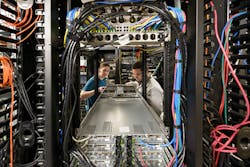This file type includes high-resolution graphics and schematics when applicable.
The critical role of standards in today’s environment is often overlooked, because their inherent nature is to make sure you don’t notice it working. Imagine going on a job interview in a world without standards. If you were to ask someone for directions to your interview, they might tell you it’s 500 steps away, but they have a longer stride so you ended up having to walk 1000 steps and you were late. You take out your laptop to give your presentation, which is riddled with various ports and jacks to connect to the internet so that no matter what the room has for connections, you should be able to make something work, and you realize your battery is low on power. You take out your outlet converter because you never know what form factor of plug is in the room or at what voltage. You then open the application to show your presentation, but remember this operating system doesn’t work with that program, so you boot up the other one that you think should work.
Luckily we don’t have to try and survive in that world, thanks to standards. Standard bodies like 802.3 are developed and maintained by independent organizations comprised of many companies who have a stake in the industry. Roadblocks are often averted by first proving that a prospective technology has market potential and technical feasibility. However, forecasts are not always correct.
Differing manufacturer implementations can also slow down the standards process. If a group can prove that a project does have the broad market potential, compatibility, a distinct identity, technical feasibility, and economic feasibility, and makes its way through the stages of the standardization process, the biggest roadblock is still to come. Having a perfect standard that fixes every issue is only good if it’s implemented, and one specific project that comes to mind is Auto-Negotiation.
Very important to the Ethernet architecture and technology as a whole, Auto-Negotiation is an algorithm defined in IEEE 802.3u to ensure Fast Ethernet worked with Ethernet. When Gigabit Ethernet was introduced, the Auto-Negotiation protocol was enhanced to make sure devices resolved to the highest priority technology type. The Auto-Negotiation process was cleverly designed to take advantage of the signaling available in the lowest common denominator technology, allowing future development to be backwards-compatible while still advancing.
The actual procedure was designed to be extremely simple in that this handshaking algorithm relies on both devices advertising what technologies they support simply by setting particular bits. Each of which indicate a technology in a defined word length, then a highest common denominator approach is used to begin link signaling.
Bumps in the Auto-Negotiation Road
Despite the simplistic nature of the algorithm, non-compliant devices and misunderstanding of how the standard was designed to work led to rampant disabling of Auto-Negotiation, which caused headaches for years. One of the major reasons for confusion was that prior to Auto-Negotiation, both the link speed and the duplex were manually configured.
To take advantage of full-duplex capability, most IT professionals did enable this mode. But during the standardization process, to be the most backward-compatible, Auto-Negotiation would choose to enable half-duplex mode if it detected that the device it connected to didn’t support Auto-Negotiation. This led to many situations where a mismatch occurred in the duplex and, therefore, massive packet loss. Rather than resolve the issue by forcing the older devices into half-duplex, Auto-Negotiation was frequently turned off.
Fortunately when Gigabit Ethernet was standardized, Auto-Negotiation was required to establish links, leading to more thorough testing and higher rates of compliance. As a result, users are mostly unaware that the Ethernet they use performs this vital handshake everyday.
Extending the Protocol
This Auto-Negotiation scheme has been extremely successful for structured cabling (twisted-pair) -based Ethernet, including new speeds such as 2.5, 5, 25, and 40GBase-T. However, its underlying technology doesn’t fit well in a high-speed serial-link-based environment, where you would find direct-attach twin-axial copper connections or backplanes.
To resolve this, the IEEE 802.3 working group defined a new Auto-Negotiation protocol for those applications, found in Clause 73. This protocol is based on the twisted-pair algorithm, but takes advantage of the both the higher speed and continuous signaling, rather than pulses, to more quickly resolve links. This was originally intended mainly for backplane physical layers operating from 1 to 10 Gb/s. In a repeat of history due to the nature of the backplane environment, though, there has been continued malaise for rigorous testing and conformance to this specification.
With new technologies and standards being deployed, the importance of the implementation of Clause 73 Backplane Auto-Negotiation was acknowledged by making it mandatory for IEEE 802.3 100Gb Ethernet compliance. Yet, as has been demonstrated in the several most recent “plugfests,” many devices did not achieve a link using Auto-Negotiation and instead relied on a special configuration to manually set the speed.
Plugfests are events focused on fostering the interoperability of products by bringing together implementers from many different companies in a neutral environment to drive compliance and debug implementations to help bring products to market faster. They’re typically held early in a technology’s evolution, be it late in the standardization period or in the early deployment phase.
Auto-Negotiation (Aneg) conformance is critical for all speeds greater than 10 Gb/s. That’s because, in addition to selecting the best possible operating speed, Aneg is now used as a precursor to a second stage of establishing links called “link training.” Link training allows devices to configure their transmitters and receivers to optimize the electrical performance through a mutual exchange of data prior to the full link being established. When devices are manually connected, this optimization cannot take place.
This issue is only going to be compounded as the flavors of higher-speed Ethernet increase from just 10 Gb/s, 40 Gb/s, and 100 Gb/s to include 50 Gb/s, 200 Gb/s, and 400 Gb/s. The sooner this issue is addressed, the fewer problems consumers will face as these technologies become widely deployed.
Keep the “Auto” in “Auto-Negotiation” and let’s not relive history. With the inception of 25GbE and the reckoning of 50G, 100G, 200G, and 400G Ethernet, Auto-Negotiation support needs to be addressed sooner rather than later to ensure interoperability and ultimately the success of these higher speeds.
Jeffrey Lapak is Enterprise Industry and Operations Strategic Manager & Associate Director, and Michael Klempa is Technical Manager, Ethernet and Storage, at the University of New Hampshire InterOperability Laboratory (UNH-IOL).






